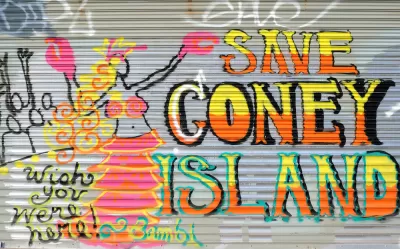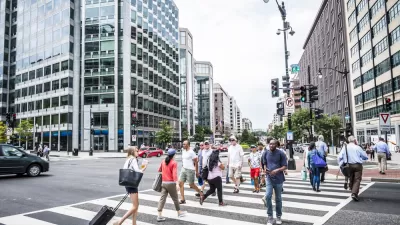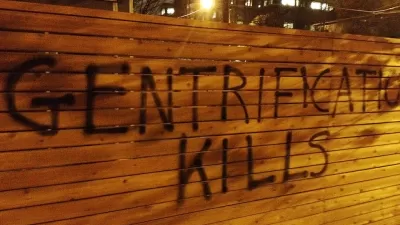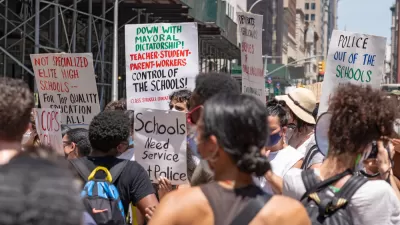Governing's recent study of gentrification systematically exaggerates gentrification in a variety of ways.

The ordinarily responsible Governing magazine is running a study of gentrification on its website; the study purports to show high levels of gentrification in some cities. For example, the study claims that 29 percent of New York's poor census tracts have gentrified.
But the methodology of this study is a bit suspect. It measures gentrification not by income or poverty, but by two criteria: (1) rising home values and (2) the growth of college graduates. The first method means that if people are growing poorer due to high housing costs, their neighborhood must be growing richer. It seems to me, however, that a neighborhood is not richer just because it is experiencing a housing bubble, or because it did not suffer a housing bust.
To be sure, there is some relationship between housing values and gentrification: other things being equal, higher incomes lead to higher demand lead to higher home prices. But other things are never equal: for example, in a small census tract with only a few houses, one or two condo buildings can skew average values upward.
The second element is also a less than ideal measure. In 1970, only 10 percent of Americans over 25 were college graduates—a percentage that nearly tripled over the following 40 years. Between 2000 and 2010, the percentage of college graduates increased in every single state. As college educations have become more common, I suspect that even the poorest places probably have more college graduates than they did a few decades ago. So if more college graduates=gentrification, one will naturally find gentrification everywhere. (To be fair, Governing used growth in college graduates rather than the raw number of graduates as a measure of gentrification; however, even less than explosive growth qualified census tracts as gentrifying. For example, one Kansas City census tract was classified as "gentrified" although its percentage of college graduates increased from 6 percent all the way up to 11 percent- a level only slightly higher than that of the city's poorest areas. The study described another neighborhood as "gentrified" because the percentage of graduates tripled- overlooking the fact that the percentage increased from 3 percent to a still-dismal 9 percent). Similarly, in Atlanta the dirt-poor Vine City neighborhood (where the median household income was under $20,000) was counted as "gentrified".
If gentrification means "more rich people" or "fewer poor people," it seems to me that a more appropriate measure of gentrification should address income: did incomes rise or fall? Did poverty rise or fall? And even if poverty fell, is a neighborhood's poverty rate anywhere close to suburban levels, or did an place with super-high poverty rates merely become a place with high poverty rates?
In addition, it seems to me that any study of gentrification should study degentrification as well: that is, to what extent were rising incomes in some urban neighborhoods balanced out by falling incomes and rising poverty in other neighborhoods? I suspect that a study considering this element would yield radically different results.*
*In particular the City Observatory website contains a wealth of data (pun intended) on neighborhood poverty.

Alabama: Trump Terminates Settlements for Black Communities Harmed By Raw Sewage
Trump deemed the landmark civil rights agreement “illegal DEI and environmental justice policy.”

Planetizen Federal Action Tracker
A weekly monitor of how Trump’s orders and actions are impacting planners and planning in America.

The 120 Year Old Tiny Home Villages That Sheltered San Francisco’s Earthquake Refugees
More than a century ago, San Francisco mobilized to house thousands of residents displaced by the 1906 earthquake. Could their strategy offer a model for the present?

In Both Crashes and Crime, Public Transportation is Far Safer than Driving
Contrary to popular assumptions, public transportation has far lower crash and crime rates than automobile travel. For safer communities, improve and encourage transit travel.

Report: Zoning Reforms Should Complement Nashville’s Ambitious Transit Plan
Without reform, restrictive zoning codes will limit the impact of the city’s planned transit expansion and could exclude some of the residents who depend on transit the most.

Judge Orders Release of Frozen IRA, IIJA Funding
The decision is a victory for environmental groups who charged that freezing funds for critical infrastructure and disaster response programs caused “real and irreparable harm” to communities.
Urban Design for Planners 1: Software Tools
This six-course series explores essential urban design concepts using open source software and equips planners with the tools they need to participate fully in the urban design process.
Planning for Universal Design
Learn the tools for implementing Universal Design in planning regulations.
Clanton & Associates, Inc.
Jessamine County Fiscal Court
Institute for Housing and Urban Development Studies (IHS)
City of Grandview
Harvard GSD Executive Education
Toledo-Lucas County Plan Commissions
Salt Lake City
NYU Wagner Graduate School of Public Service






























